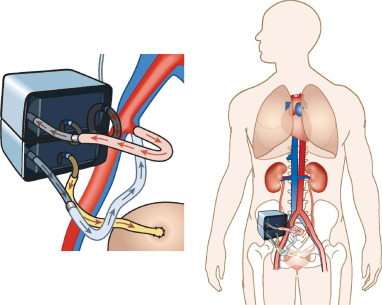
Toxic wastes produced by the breakdown of food in the body are normally removed by the kidneys. The kidneys also regulate the body’s fluid and salt content. If they go wrong, the poisonous wastes accumulate in the blood and fluid builds up, which eventually causes uremia, a disease which kills thousands of people each year.
Kidneys can sometimes fail without warning, but more common is ‘chronic kidney failure’, in which the kidneys deteriorate gradually. The only ways of dealing with kidney failure are either to transplant a healthy kidney or to remove the waste products artificially.
Waste removal is done by dialysis machine which acts as an artificial kidney, filtering the wastes out of the blood. The process is often performed at home by patients trained to use the machine. One method, haemopdialysis, involves inserting two needles into the patient’s arm or leg – one in an artery, the other in a vein. Each needle is connected by a piece of tubing to the dialysis machine.
Blood flows the patient’s artery into the machine where it is mixed with a drug called heparin to stop it from clotting. It is then passed through a semipermeable coiled Cellophane tube, which is immersed in a warm chemical bath. The perforations in the Cellophane are large enough for the small molecules of waste to filter through them, but the blood cells, which are larger, remain inside the tube. Once the waste products have been filtered out, the cleansed blood is mixed with an agent which counteracts the heparin and is pumped back into the patient through the needle in the vein.
Three sessions a week
Someone who requires this mechanical form of waste removal has to undergo three eight-hour sessions a week, connected to the machine.
Another filtering system, called peritoneal dialysis, does not require the machinery used in haemodialysis. The peritoneum is a large protective sac of flexible tissue, surrounding the abdominal organs. These organs have a plentiful blood supply, and being close to them the peritoneum is well situated to act as a filter for unwanted molecules.
In peritoneal dialysis, the patient has a small piece of tubing inserted through the abdominal wall into his or her peritoneum. A special liquid known as dialysing fluid is then poured into the abdominal cavity via the tube. The fluid attracts the waste products from the blood in the abdominal organs, and is then sucked out. The whole process takes up to 12 hours, and is performed two or four times a week.
The type of dialysis that patients revive depends on a number of factors, including age, the availability of machines, and their ability to insert needles into themselves. In some countries, the cost of machines is also a consideration.
Picture Credit : Google




